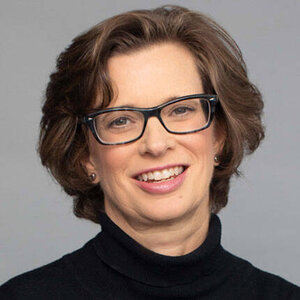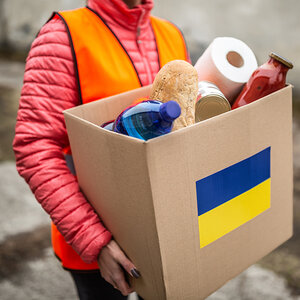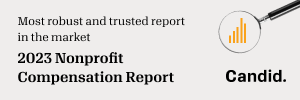Michelle Nunn, President and CEO, CARE USA: 77 years of using history, experience, and scale to respond to global humanitarian crises
November 21, 2022
Michelle Nunn has served as president and CEO of CARE USA—one of the largest humanitarian organizations in the world—since 2015. Her career of service as a social entrepreneur and nonprofit CEO includes co-founding the volunteer-mobilization organization Hands On Atlanta, which grew to become one of the nation’s largest civic action and volunteer networks. She then led the merger between Hands On and Points of Light, the world’s largest volunteer-service organization, where Nunn served as CEO from 2007 to 2013. In 2014, she entered politics and was nominated as the Democratic candidate for the U.S. Senate from Georgia, following in her father’s footsteps.
At CARE, Nunn leads a global team of 7,000 people working in over 100 countries to save lives, defeat poverty, and achieve social justice. As CEO, Nunn has led CARE’s fundraising and impact to new levels in the areas of crisis response, food and water, health, education and work, and climate change, with a focus on gender equality. CARE’s fiscal year 2021 revenue was the highest in the organization’s history, with programs reaching more than 90 million people.
PND spoke with Nunn about CARE’s Crisis of Response Campaign during the COVID-19 pandemic, the relaunch of the CARE Package; the organization’s humanitarian surge fund in support of aid in response to the crisis in Ukraine; CARE’s efforts in assisting nations in need amid multiple humanitarian crises; its work combating poverty in communities worldwide; and working to enhance girls’ and women’s ability to accumulate wealth and access education on a global scale.
Philanthropy News Digest: During the COVID-19 pandemic, you led a $100 million Crisis Response Campaign that met its target early and expanded to $150 million, given the urgency of needs worldwide. What are your plans for the additional $50 million in funds, and how has the relaunch of the CARE Package taken shape?
Michelle Nunn: We were profoundly grateful for the extraordinary generosity in response to the COVID crisis over the last few years. I believe that, in some measure, people felt a sense of interdependence and solidarity with people around the world. And yet we still see a very low vaccination rate in many places—a fraction of a percent in places ranging from Burundi to the Democratic Republic of the Congo. So CARE is continuing to both advocate for and ensure that communities have the capacity to distribute vaccines. We particularly focus on the last-mile delivery.
As you said, we started with a $100 million campaign. We raised it to $150 million based upon the generosity of donors and supporters, and yet we've seen the challenges continue to morph as it relates to the impact of COVID in many low-income countries. It wasn't limited to the health impact itself; it was the downstream impacts of the closing down of economies: the inflationary forces and the lack of economic opportunity. So those who were already most vulnerable were hit the hardest in many ways, both in terms of communities that might have been living in poverty and low-income countries—where they did not have trillions of dollars to invest in the safety nets that protected so many of our citizens in United States, for instance.
We were profoundly grateful for the extraordinary generosity in response to the COVID crisis over the last few years. I believe that, in some measure, people felt a sense of interdependence and solidarity with people around the world.
That work continues, but now we’re evolving to address a global hunger campaign because we’re now facing this extraordinary crisis around the world. Partly it’s the continued long-term impacts of the COVID crisis from an economic perspective, but it’s also the Ukrainian crisis—the loss of grain imports and everything from fertilizer to gas and the inflationary prices, and a whole host of other impacts.
So there’s a lot to do in the world right now for CARE and other actors that are trying to again stand in solidarity with those who are facing crises and emergencies. We have pivoted in some ways to take our story and to sort of reimagine and recreate this “care package” for a new era. And that’s taking on a couple of different forms. One is that in the wake of COVID, CARE started to operate for the first time here in the U.S. We created partnerships with organizations like TaskRabbit to deliver meals to people who were homebound, and we’ve delivered over 13 million care packages over the last couple of years. And we are also taking the idea of the care package and imagining: What does the digital care package look like? How do we equip, for instance, women smallholder farmers with phones that have applications that enable to them to have greater access to marketplaces, accumulate their savings together with others in their community, and invest in businesses? So I would say the care package, as an idea of solidarity and interdependence and connection, and then as a practical application in new ways, has never been so relevant.
PND: We’ve reported that organizations like the Arthur M. Blank Family Foundation have provided funding through CARE USA’s humanitarian surge fund in support of aid in response to the crisis in Ukraine. What work is CARE USA doing in this regard? What has been the impact?
MN: There have been several buckets of investment, and the Blank Foundation has been an extraordinary contributor to, for instance, our surge fund, which we apply in places ranging from Ukraine to Pakistan, to Haiti, to the DRC. The surge fund is just that: It’s the idea that we can surge funding, sometimes preemptively, as we see crises emerge and try and get there first and create models of resilience and the capacity to do preplacement. So, if we see a hurricane coming and we know that a bridge might wash out, we have already placed food on the other side of that bridge so people can access it. For instance, it might mean that in India, when we see trend lines going up in terms of COVID, we create a model for creating a health clinic that can respond within 48 hours. Then they replicate that 15 times over, but we were able to give them that initial investment that became a proving point before other dollars followed.
I think the entire world has been surging funds in new ways to the Ukrainian crisis in particular. CARE has been focused on those people who have been displaced during the conflict—those that fled beyond the borders but also those who had to find new ways of sheltering within Ukraine. And we’re making basic provisions of food, shelter, cash—cash assistance is so important, especially for those who are most vulnerable— and we also have some innovative programs. For instance, in Poland, in partnership with local organizations, we are hiring teachers from Ukraine and Ukrainian refugee teachers who work in the Polish school system. They’re able to ensure that the kids who have fled and left everything they know are able to learn in their own language as they make the transition to new communities. And at the same time, we’re supporting the school system to lift up this extraordinary set of responsibilities for a new a new community of kids. So that’s an example of the sort of multi-pronged response that is helping both the adjustment of the refugees, and the host communities that are trying, with such generosity but also sometimes with great difficulty, to absorb hundreds of thousands of new community members.
PND: And I can imagine learning loss is probably a large concern for parents and kids in a totally new environment.
MN: Exactly. I talked to one of the teachers who had fled, and she was describing how she was having weekly calls with her 25 elementary school students via Zoom just to keep them connected to one another. How many of them were still in conflict? How many of them had fled? And they were all facing both the enormous challenge of readjustment but also their parents were trying desperately to ensure that they're not suffering enormous learning loss as well.
PND: And that is especially important when there’s so much uncertainty. So it seems humanitarian crises have exploded, with what’s happening in Ukraine and political tensions amid droughts and other things like that in South Sudan, and those affected by violent conflict and economic crisis in Myanmar, Ethiopia, Yemen, Afghanistan, Syria, and elsewhere. How is CARE poised to bring relief and assistance to those regions that are most in need?
MN: It is a tremendously long list, right? And in our 77-year history at CARE, I don’t think we’ve ever had a time when we’ve had that this threshold of humanitarian needs that are so widely dispersed across so many different populations that are not only locally contextualized in terms of conflicts—if you think about Yemen or Afghanistan or South Sudan—but also that are hit across the board, first by a pandemic and now a hunger crisis. And so, CARE is trying to use the entirety of our muscle, history, experience, and scale to respond to those crises. We’re also working to ensure that we’re using the localized knowledge we have from decades of experience in each of these places—because, for the most part, these are places where CARE has operated for many, many years, during and after a crisis or disaster.
in our 77-year history at CARE, I don’t think we’ve ever had a time when we’ve had that this threshold of humanitarian needs that are so widely dispersed across so many different populations that are not only locally contextualized in terms of conflicts—if you think about Yemen or Afghanistan or South Sudan—but also that are hit across the board, first by a pandemic and now a hunger crisis.
We are particularly focused on ensuring that we can address the real enormity of the hunger crisis. And if you think about where we’re seeing some of the worst of that hunger crisis, it’s this combination of climate and conflict. The Horn of Africa is where five consecutive years of drought have created unprecedented difficulties and challenges. And in the context of Ethiopia and Somalia, you have conflict overlaid on top of that, compounding those challenges. CARE is trying to apply not only the scale and muscle but also the local understanding and context that we have.
We’re also taking a three-tiered approach in terms of how we’re doing in our work. One is: How are we providing an immediate emergency response in terms of the provision of cash or direct food assistance? How do we get food where people need it over the coming months when they simply don’t have it? The second is: How are we helping people, for instance, grow more food? It’s a lot more effective and efficient if smallholder farmers have the capacity to grow a sustainable crop and to create higher yields that can support the broader community. And the third dimension of our work is advocacy and lifting up these challenges so that we can secure the necessary global response. So many of the crises that you just listed so many of them have received only 10, 20, or 30 percent of what the United Nations has said is going to be required in order to meet the needs of the people. So we ask for accountability from the global community for our global and collective response to these crises.
PND: Right, that’s a whole other aspect that we’ve been exploring about the UN Sustainable Development Goals and where there’s progress and where they may be falling short. Now poverty is a multifaceted issue, and we understand that it requires efforts from various angles to combat the toll it takes on communities. What are some of CARE USA’s approaches to addressing the issue, and how can NGOs and philanthropic entities support those strategies?
MN: One of the things that CARE recognizes, and I think increasingly that the world recognizes, is that you have to look at poverty from a holistic, multi-sectoral perspective. We look at broader systems—food and water systems, health systems, and educational systems—and recognize that these are often overlapping and overlaying in terms of how they impact families and communities. For example, CARE runs, manages, and orchestrates the largest micro-savings program in the world. We have over 13 million people who are part of our what we call the Village Savings and Loans Associations program, and it’s small groups of people—mostly women—who come together and save together, and then use the money to start small businesses but also to create a safety net for themselves and for their community. And we’ve seen extraordinary results.
In fact, some of the poorest people in the world are saving together and then investing in one another—over $500 million on an annual basis. So, we take those platforms, which are a part of a financial inclusion effort, and we overlay a variety of different interventions, such as gender-based violence interventions. How do you engage men in the conversations? How do we change the dynamic around women, stature, and power capacity within communities and within families? We also overlay two nutritional interventions where we’re helping support women who are diversifying their own income and helping them understand the implications of ensuring that they are able to feed their children a nutritious diet, not just from a calorie perspective but also from a nutrition perspective.
In fact, some of the poorest people in the world are saving together and then investing in one another—over $500 million on an annual basis. So, we take those platforms, which are a part of a financial inclusion effort, and we overlay a variety of different interventions, such as gender-based violence interventions.
When you take those pieces and add them all together, you really see a kind of transformational set of possibilities for families that can make the difference in addressing what we recognize is the multidimensional nature of poverty.
PND: In doing some research around guaranteed income pilots here in the U.S., and from what I’ve read, they do work, and I wish we could get that moving a little forward.
MN: I think there’s a lot that we can learn from international development that is applicable in the U.S. context, which is one of the things that CARE is interested in applying because there are similar dynamics to the multidimensional nature of poverty here in the U.S.
PND: You mentioned the assistance microfinance is bringing to women, and I'm also looking at those gaps in terms of women's ability to accumulate wealth and access education. CARE states that 131 million girls worldwide are missing out on school, and girls are 50 percent more likely to lose the opportunity to access education than boys. What type of assistance do women and girls need to create solutions to close persistent gender gaps worldwide in the economic, educational, and other spheres?
MN: CARE recognizes that we have to tackle this from a variety of levels. Certainly, from an educational perspective, we recognize that girls often do miss out on periods of their education for a variety of reasons. It can be a lack of money, in which case boys are prioritized to enable them to go to school. It can be menstrual hygiene, where girls are missing a week a month, for instance, because they just don’t have bathroom facilities in the school, and that precludes them from participating. Girls are also asked to take on chores—literally the provision of water, the provision of firewood, those chores that are essential to a family functioning and get placed disproportionately on women and girls. So all of those things can contribute to a girl's inability to go to school.
One of CARE’s interventions is what we have called our SOAR (Strengthening Opportunities for Adolescent Resilience) program, and it’s focused on girls who have missed months or even years of schooling, which might preclude them from being able to go on to secondary education. We have an accelerated program that, within one year, enables them to go on to continue their high school education. It has something like a 90 percent plus graduation rate. And if you look at the statistics, among girls who graduate from high school, their children are 2.5 times more likely to live past the age of 5. Their lifetime incomes go up by 10 to 20 percent, so it is a huge change to have a fully educated populace of girls—to enable them to live up to their full potential.
And then the next obstacle is that you have to make sure that they have full access to the marketplace and job opportunities and that they have the opportunity for financial inclusion in the ways that we just talked about, as it relates to our micro-savings program. All of those are pieces of the puzzle that help ensure that communities and nations are enabling the full participation of girls, and that ranges from education to health to economic opportunity.
We recently published a report about the disproportionate impact of the hunger crisis on women and girls: 150 million more women are hungry in the world than men, and some of those specific examples brings home why it’s helpful and important to target women and girls.
—Lauren Brathwaite





